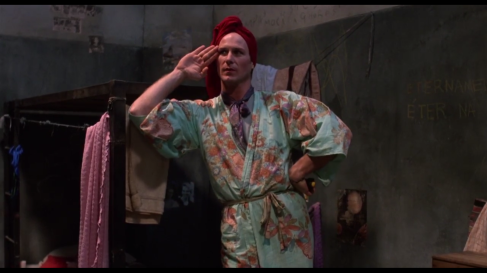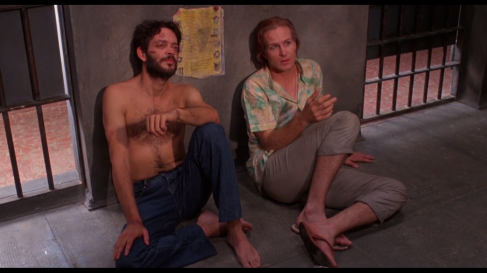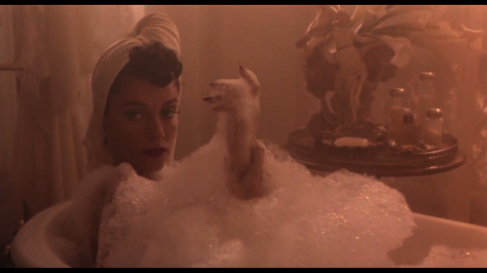Few films can be defined as special, in the unique and different sense of the word. Some examples are The English Patient, Oldboy, La Jetée, 2001: A Space Odissey. Some are excelent, some are interesting, some are simply different. There is surely nothing quite like Kiss of the Spider Woman, even if its formula – a story within a story – is frequently used in cinema. The cast, the directing, the skeleton of the plot, the social content: everything makes it a very, very unusual movie.
Mostly shot in closed spaces and adapted to the English language and to a Brazilian political situation by the Argentinian-born Brazilian director Héctor Babenco, the film has an atmosphere of its own. All the cast, including the Brazilian actors, performs in English, but the Brazilian nature of the story is preserved: there are Brazilian jokes carved on the walls behind Molina’s bed, and Valentin Arregui is frequently seen next to a soccer poster. Nevertheless, the story refuses to refer to specific details about the cell mates’ situations, and William Hurt’s portray of Molina, an effeminate homosexual prisoner, turns the story into a universal character study and an essay on homosexuality.
Kiss of a Spider Woman centers around the relationship between Molina and Arregui (Raúl Juliá), a journalist marked by political persecution and violent interrogations. While Arregui’s only goal is to survive in jail and keep his information from the questioning of the warden (José Lewgoy) and a Secret Service Policeman (Milton Nascimento), Molina doesn’t feel the same way: he was arrested for corrupting a minor, and often tries to mentally escape from his condition by telling his cellmate about films he watched and short stories he’s heard of. It’s unclear whether Molina makes up the stories or is just a storyteller with a good memory, and that uncertainty shapes his relationship with Arregui in many ways throughout their prison time together.
One of the peculiarities of this picture is the, say, Americanization of the story. It’s visible that most actors don’t feel comfortable performing in English, but they do excellent jobs. The strong Brazilian accent in their performances is noticeable, even when the character of Sonia Braga is seen speaking in French. The awkward passages that happen outside of the cell, especially those in the perfectly badly acted stories, contrast with William Hurt’s calculated performance and Juliá’s character development, who reveals a man much different from the one we see in the beginning of the story.
Hurt’s performance is surely one of the most curious performances ever to win the Oscar for Best Actor. He is not the strong character fighting an unstoppable adversity, the wise man who gets as mad as hell or the solid hero. His performance’s brilliance relies simply on his transformation, on blending with Molina’s persona. Luis Molina is effeminate without being exaggerated or stagy, friendly and compassionate without being sentimentalist; joyful and imaginative without being a sheer escapist. He carries it all on his shoulders, and goes his own way to teach Arregui lessons.
Kiss of the Spider Woman
Year: 1985
Director: Héctor Babenco
Cast: William Hurt, Raúl Juliá, Sônia Braga, Milton Gonçalves, Herson Capri, Nuno Leal Maia
Academy Awards: Best Actor (William Hurt); Best Picture (nominated); Best Director (nominated); Best Adapted Screenplay (nominated)
Cannes Film Festival: Best Actor (William Hurt); Palme d’Or (nominated)



